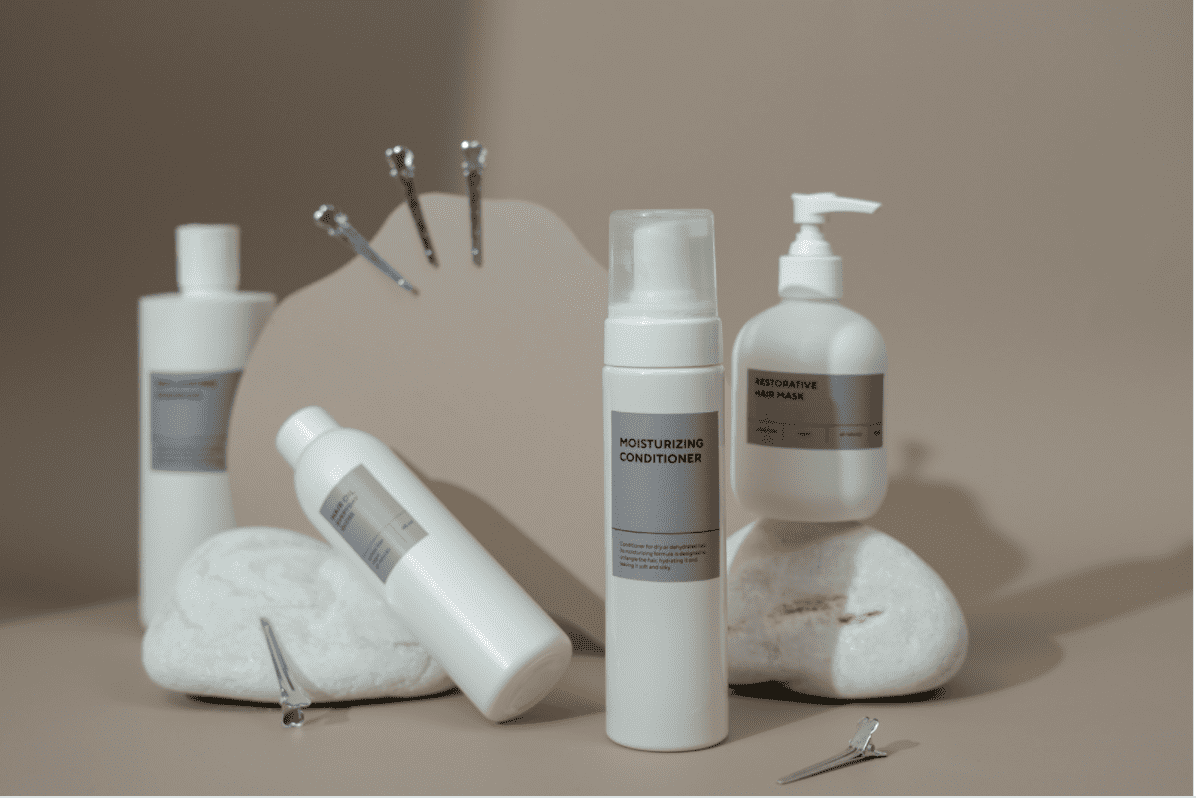Starting a hair product line isn’t easy, and without a well-known brand name behind you, competing against drugstore goods and other salon items will be difficult.
Furthermore, a failing product line may result in angry and disgruntled customers, putting your brand’s reputation in jeopardy. So, how can you establish a hair product line without jeopardizing your company’s reputation?
You’ve come to the perfect site if you want to learn how to establish your hair product brand. We created a comprehensive guide to help start and grow a hair product line from the ground up in this article.
Let’s get started.
Pros & Cons Of Starting A Hair Product Line

When it comes to a successful salon business, introducing a hair product line is even more challenging. To start, you should know the pros and cons of launching a product line as one of your first steps.
This list of pros and cons will help you determine whether or not investing in one is worth it.
Pros
- Work from home: Selling hair products doesn’t need a physical store or office space, and you don’t even need a warehouse to store your inventory. You can choose how much time (or not) you want to put into this business, and depending on your life circumstances and goals, it varies.
- Stream of alternative income: If your salon has to cancel appointments or can only accommodate a limited number of clients, you could build on your business with the help of some hair products.
- Starting at a low price: You can get started with your business for as little as $2,500. If you’re running the show solo, you’ll also save on labor costs until your company is big enough to justify hiring someone to help out.
Cons
- Competition is fierce: The hair care industry is very crowded. If you want to get through this space successfully, identify a key market and know what people are looking for, precisely providing what they demand.
- Dependence on suppliers: Most hair care businesses don’t physically make the products themselves. They will buy from a supplier according to their specifications and choose the right one for that business. You rely on them when it comes down to it.
- Investment of time: If you want to market a successful hair product line, then you’ll need to put in a lot of work to promote your products and customer service. But if you’re confident that it’s something that can be done, start planning.
Does this sound like something you’d be interested in? If so, we can move forward.
The process of creating a Hair Product Line

Here are the steps you should take to get started:
1. Understand your product’s purpose
A unique selling proposition is a product’s or company’s primary argument to the customer. Every business needs one, and it involves looking at their competitors’ offerings and determining what they do better than them.
Developing this type of message for all products may seem overwhelming, but some strategies can help break down an otherwise complicated task:
- Start with your mission statement – try to identify how you want customers to perceive you as a company by reflecting on why your business exists in the first place;
- Determine if any features or benefits stand out from other similar businesses who offer those same products as well – these would be good starting points for developing copy explicitly related to those features/benefits;
- Brainstorm different types of messaging until something sticks – keep coming up with other ideas even if only one sentence evolves into more strategic content later on.
2. Build prototypes
Don’t give up! You will find the right one in time. Even if you can’t think of anything to start with, work on expanding your knowledge about what interests you, and who knows when it might click? The key is persevering; nothing good comes easy after all.
Keep trying until you figure out something that suits your needs or desires best.
3. Use volunteers to test your products
It is essential to find out what they are looking for and how you can provide it. This may be through social media, surveys, or interviews. This way, you will know if your product could interest them at all before investing too much time in research on the possibility of marketing to them.
4. Make your hair product more effective
A lab expert may be able to help you identify bacteria in your home’s soil. If this is the case, they can recommend ways to get rid of it and avoid future problems with toxic substances on the ground. Laboratory experts are also trained to find solutions that will work best for any given situation within their field.
5. Choose the package and design
Graphic designers will work on your product’s color, layout, typography or advertisement. They’ll help you create a memorable image to represent your brand.
Your graphic designer may work with creatives in other fields such as advertising and marketing professionals. Graphic design is more than simply making things look good: it’s about conveying an idea that communicates what makes your company special.
6. Large-scale production
You can produce your cosmetics or choose to bring in a private label company. Making quality cosmetic products on site is possible with the right ingredients, lab equipment, and recipes.
Along with this option, there are many other opportunities for retailing makeup, such as joining an online marketplace like Etsy or setting up an independent website where you can sell directly from home without having any costs associated with selling at a brick-and-mortar store.
A Step-by-Step Guide To Starting A Hair Product Line

You can start by focusing on the technical aspects. Ensure that your products do not contain any harmful chemicals and that they’re safe for public use.
Next, you need to work out how much customer feedback you should consider when creating new hair care products; it may be wise to focus on what people want rather than risk a bad reputation with an unpopular product line!
Additionally, don’t neglect accessibility: if a hairstyle is difficult or impossible to maintain without using certain hair care products, those will likely become popular too.
Are you pumped? Let’s begin.
Step 1: Develop an action plan
If you manage the project hair care line, you must give them you’re all. To get started, take the time to learn how other brands have done it! In this section, we will look at the steps needed for success.
It would help if you looked at all the costs you would incur as you fund the marketing of a hair product line. The number of variables involved will determine the cost, however here are some common costs to consider:
- Licenses and business formation: Depending on where you live, you need to register your product with the appropriate office (like the FDA) and pay for applicable business licensing fees. You might also have to pay taxes.
- Payment processing: Your salon might have a payment processing system of some sort, but you will need an additional one to accept online transactions.
- Equipment: If you choose to manufacture your products in-house, expect to pay for expensive laboratory and factory equipment. Partnering with a supplier is usually the better idea.
- Payroll: You may be able to handle launching the product line and processing the initial orders alone, but you might eventually need someone else to help.
- Liability insurance: Liability insurance is wise to have if a client files a complaint against your product. It ranges from $500 to around $2000 per year. In some locations, it’s legally required.
- Website: Owning an online business is different from selling hair products at your salon. If you want to look more credible, get your domain name. Also, create a Gmail account- one that’s separate from the current website- specifically for this side of the business.
- Inventory: If your supplier requires a certain amount of upfront inventory, you might be swayed to pick one over another. You may have been influenced by the initial stock cost rather than other specifics in this decision.
Step 2: Decide which hair products to sell
The first step is knowing your target demographic. Different kinds of people have different hair types, and you cannot appeal to everyone.
You could start by observing the people who come into your salon. What treatments are they asking for most often? What demographic groups do they fall into?
You might want to create a product line that caters to a particular kind of hair, such as curly or thin-hair products, which will be helpful for those with this type of hair problem in need of an answer from you! Or maybe you would like to cater specifically to older women or college students on a budget – when understanding who your target market is, it makes it easier to work out what types of products will best match their needs and wants.
Step 3: Select a supplier or make it yourself
When it comes to small businesses, the best way is to partner with a supplier. This means that you work with a manufacturer and give them your product specifications, where your name or branding will be on these items.
Many suppliers require you to order specific amounts of product upfront if there are no defects in the manufactured goods after use from customer reviews. Suppose this makes sense so far – good. But not only do many business owners find themselves stuck with a surplus of inventory that they’ll never sell because their product didn’t live up to their expectations.
Some manufacturers take advantage of this by charging higher prices than expected because they know people have already put money onto an order before being aware of any issues ahead of time.
Always do your research and ask around. The hair salon industry is tight-knit, especially for small independent salons, so fellow salon owners will be happy to share the suppliers they love with you. So don’t be afraid to ask someone who’s been in the business longer. You can also read online reviews and request samples before making decisions about products or services.
Step 4: Test the products after receiving them
Before you start to market your products, it’s essential to test them first. Companies like Revlon spend thousands of dollars trying their new product ideas before they launch a line – but that isn’t necessary for everyone.
Here are some additional steps you can take:
Receive the sample products and try them out yourself- launching a hair product line
If everything seems fine, then it’s time to start testing. Check whether your sample products pass the sight and smell tests when you receive them from your supplier.
If something looks or smells different than expected, this might need addressing with the supplier as soon as possible so that there is no confusion around production specifications.
During these tests, it is essential not just for things on paper but also for what happens in reality, too, such as how long shampoo lathers? Does my scalp feel dry after washing myself? Is there any irritation afterward? And if so, why would I be willing to put those feelings towards other people by selling my haircare range?
You can start by asking your team members and loyal clients to test the product, giving you their quality reviews. This is crucial in releasing a successful outcome because shows how different hair types react with the formula.
Step 5: Design a brand, a website, and a domain
If you’re considering starting your hair product line, a large portion of your sales will likely come from online clients. You’ll need to pick the right brand name and SEO on your website- something that you may have been doing for other businesses previously.
First, think up a catchy name for your business. If you’ve already given the salon a title, then use this as inspiration or look at these pointers:
- It will help if you avoid names that are hard to spell.
- Check out potential brand names on Google. Choose something else if your brand name is already taken or sounds like another company.
- Don’t limit yourself to one niche if you decide later to branch out.
You can choose a name for your salon and start researching to see what the prospective clients think. Once you’ve selected a name, grab the domain right away. Register handles on social media sites like Facebook, Instagram, and YouTube.
You can build an e-commerce website using Shopify or an alternative platform, but if you want to use WooCommerce instead. Then you’ll need WordPress hosting from a reliable provider, installing WooCommerce on it; adding packaging images of your product; writing marketing copy for your product pages (with branding), and introducing yourself in short with details about any other services that might be included such as hair styling products mentioned above.
One good way to keep in touch with your customers is by creating a newsletter that sends subscribers hair care tips, special offers, and the latest updates from your business. Use a landing page builder to create an incredible-looking landing page where website visitors can subscribe.
Next up: working on SEO for your e-commerce website. We all know it’s not going to happen overnight – but hopefully, these few pointers will help you get started:
- Maintain a blog within your site and use relevant keywords to post regularly
- Use your chosen keywords in the alt text of your images, describing their content.
- You can use a plugin like Yoast SEO to help you.
It’s important to remember that local SEO is about targeting keywords too! This means by the time you start writing, make sure you include your business location in your content. If people are looking for reviews of businesses close to where they live, what better place than the internet?
Step 6: Calculating your expected income and pricing your products
It would help you decide what you want your products to cost before starting any business. Your pricing options are not limited, but two of the most common are overpricing and underpricing.
If you overprice your product, clients may view it as an unattractive deal, or that quality is low-quality for a high price mark up. Clients will be unlikely to buy this product if they feel like they’re getting something subpar for too much money spent! On the other hand, charging too little might lead people to view these items as cheap and therefore with no value at all (even if there’s not).
Both situations can damage your reputation and bottom line in different ways; make sure you know who will be purchasing from you beforehand to determine prices.
To see if your pricing is competitive, compare the products in your line with those of similar goods by competitors. How much do they charge? If your price point is very different from theirs and it’s not an exclusive product, then you might need to reassess.
Step 7: Expanding your salon’s hair product line
Your salon customers are the best target market for your hair products since you already know what they want and look for in their hair care. For example, a stylist can wash a client’s hair using your shampoo to see how high quality it is themselves.
Your professional stylists have unique opportunities to promote your brand because of their knowledge about clients’ needs and tastes. They will be able to make customized recommendations leading to loyal customers who keep coming back again and again!
Along with nurturing relationships with your salon clients, building a community online is one of the best ways to extend that engagement. The simplest way of doing this is by creating an exclusive Facebook group where you can share hair care tips and encourage discussions between members while promoting some of your most loyal customers looking stunning after visiting your salon.
As these people become more informed about their hair, you have the opportunity to introduce new products or services and build up influence in the industry.
Conclusion
Opening a hair product line with your salon is an excellent way to expand and diversify your business. Haircare products offer a variety and different sources of revenue for the business. You must dedicate enough time and energy to both (or hire someone who will).
On top of this, before you bring these products to the market, you must understand your target audience and the competition so that they’ll be able to design them accordingly. Finally – using their salon could be the perfect opportunity for promotion.
Before bringing your products to the market, you need to understand what target audience and competition exist. This will allow you to design, promote, and price your product accordingly. Finally, use your salon as a primary promotional tool- educate stylists on how to meet clients’ hair care needs with products that suit them best.



![21 Worst Shark Tank Failures And Why They Failed? [2024] 6 Shark Tank Failures](https://thehustlestory.com/wp-content/uploads/2021/11/Shark-Tank-Fails-Blog-Banner-2.jpg)



Wow, you’ve said it all. I found this really helpful, cause i was just thinking of starting my hair care business. Thanks alot.